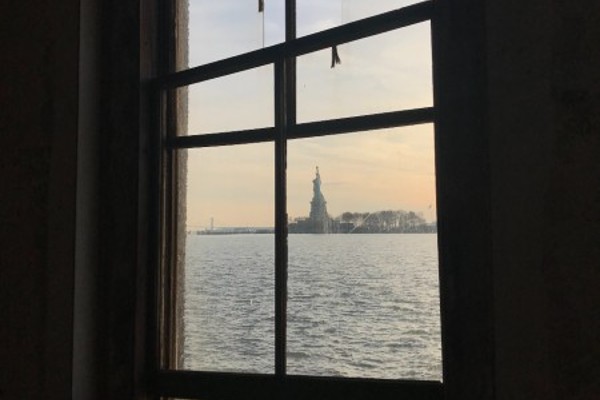While many of us are accustomed to seeing the Statue of Liberty and Ellis Island while we enjoy those amazing NYC views, few may know of the history of the Island itself. Ellis Island is best known as the ‘doorway to America’ for millions of immigrants, but it’s also a landmark in its own right. The Hoboken Girl took a deep dive into the history of the Island. Read on to learn something new about this national landmark, right here in Hudson County.
New Jersey vs New York
Less than one-third of what is today called Ellis Island is made up of the original landmass that Samuel Ellis sold and left his name on during the American Revolution and what the Lenni Lenape people called Kioshk or Gull Island.
The rest of the island is landfill. All of it sits in New Jersey waters, sparking a 1998 ‘King Solomon’ decision by the Supreme Court to divide the island between NY and NJ.

That legal battle between the neighboring states followed the official 1990 opening of the Ellis Island National Museum of Immigration run by the National Park Service. Today, only a fraction of the many visitors who take a ferry to Liberty Island and to Ellis Island see first-hand what sits on the 24-acre area of Ellis that is now in New Jersey.
Many, if not most, visitors to Ellis Island leave without knowing the medical history that was made on the other two-thirds of the Island. But before getting into the stories of the abandoned medical buildings on the south side of the Island, a bit of explanation about what Ellis Island means to our current day is needed.
Read More: The History of Jersey City’s Former Roosevelt Stadium
Ellis Island + the U.S.
Ellis Island’s designation as an Immigration Station in 1892 signaled great change to the country’s immigration policy. Until 1891, individual states controlled immigration. German residents in St. Louis printed brochures marketing Missouri to residents of Bonn and Cologne, making the case that the Mississippi and the Rhein are basically the same river and farmers from Germany would surely find themselves at home there.
The Norwegian farmers of Wisconsin and Minnesota were attracted by similar appeals. These localized efforts were part of the long history of Northern and Western Europeans settling U.S. territory as they displaced Native Peoples. The Federal Government’s assumption of direct control of inspecting, admitting, rejecting, and processing all immigrants through the Immigration Act of 1891 would change the country forever.
For example, think about the “all-American” diner culture that entrepreneurial Greek immigrants began. Then reflect a minute on how much Italian culture permeates our lives, regardless of our Italian heritage. These Southern Europeans were not much welcome into the U.S. until Ellis Island. Eastern Europeans too — those groups could not find easy entry into the U.S. prior to the Ellis Island years.
Even the Harlem Renaissance is closely tied to Ellis Island. Black Caribbean immigrants in NYC went from 1.5 percent of the city’s population in 1900 to 12.7 percent in 1923. Those Jamaicans, Dominicans, Haitians, Cubans, Guyanans (and many others) helped invigorate the poetry, music, and intellectual discourse of the era. The federal government opening immigration up to global regions that had been restricted or excluded from entry (and would be again) shaped the true diversity reflected in this era of immigrants.
Today, something like one out of every four residents in the U.S has at least one ancestor who came through Ellis Island. Approximately 12.5 million people were inspected for immigration at Ellis Island during a relatively short period. Incidentally, however, not every immigrant had to stop at the Ellis Island Inspection Station. In fact, it was not rare for immigrants who had come through Ellis to tell their children and grandchildren, “No, no, we did not stop at Ellis Island.”
That is because only third and steerage class passengers were brought to Ellis Island. The first and second-class ticket holders in the staterooms on top of the massive steamships that stopped at the Narrows where the Atlantic meets the Hudson did not. The nostalgia, and even pride, that is today associated with an Ellis Island family history only came after the Island was abandoned and post-WWII elementary school textbooks were written to celebrate the “melting pot” of America.
Ellis Island’s Hospitals
Some of those millions of immigrants who traveled to Ellis Island did not come through with the ease of the most typical 4-5 hour process. Men, women, and children who were marked with chalk on their lapels with a symbol connoting one of many health concerns would require a trip to one of the huge Island hospitals.
For example, a marking of “F” for face might mean a tooth was swollen and the individual would need to see a dentist. A mark of “CT” for trachoma — a highly contagious bacterial infection causing blindness — meant deportation. These chalk-marked immigrants would not board the ferries going to Manhattan and Jersey City with the rest of their families.
They would, instead, visit the General Hospital which opened in 1902, or the Hospital for Infectious and Contagious Diseases which opened in 1911. Some of the ~1.5 million immigrants who were treated in those now abandoned hospitals would receive treatment and quickly resume the process of starting their new American lives. Others endured longer treatments for illnesses that were cause for isolation and with a faint hope of recovery.

The patients who were most likely to die of what ailed them in Ellis Island’s hospitals were children. That was, in fact, true for all hospitals around the world in the early half of the 20th century. Today, the inverse is true. Globally, we are more likely to die from what landed us in a hospital as we age.
What is the huge change that led to this reversal in hospital mortality demographics? Those 1920s childhood mortalities were not a result of bad parenting or malnutrition. It is the availability and prevalence of vaccines that separates the outcomes of our contemporary hospitals from those on Ellis Island.
During the time that Ellis Island’s hospitals were active, childhood diseases were a constant threat. The greatest killer of children in the Ellis Island hospitals was scarlet fever. For adults, the most common cause of death was tuberculosis (T.B.). The medical wards of Ellis Island’s Hospital for Infectious and Contagious Diseases were dedicated to illnesses that have now been largely eradicated by vaccines.
To walk through those weather- and time-battered abandoned hospital buildings, and see the measles and T.B. wards first-hand, is to walk through a historical medical moment frozen in time.
See More: A Look at Yoo-Hoo’s New Jersey Roots
A Guided Tour
A timeline exists for restoring the buildings that were abandoned suddenly in 1954 and struck hard by Hurricane Sandy in 2012. Much of the current restoration work being done focuses as strongly on the structural integrity of the Island itself as on the historical buildings.
As this work continues, the most intrepid Ellis Island visitors who don a hard hat and trek through ruins and relics of our bygone era of medical and immigration history gain insights into the human stories there by way of renowned street artist JR. French-born New York artist JR has wheat-pasted images, taken from the Ellis Island archives, onto the walls, floors, cabinets, hallways, appliances, and broken windows of the abandoned buildings. These archival photographs appear like ghostly apparitions to provide clues as to what life was like before vines grew in through the windows and stalactites formed on the ceiling where lime has leached through the concrete.

To see the not-so-creatively named Islands 2 and 3 portions of Ellis (the landfill), visitors must purchase tickets for a guided hard-hat tour with an educator for the Save Ellis Island Foundation.
Tickets to see the unrestored parts of Ellis Island are available in the Parks Department gift shop in the Museum of Immigration or online on the same site where ferry tickets are purchased. Ticket profits go toward the restoration of the many historic buildings that await their preservation.











